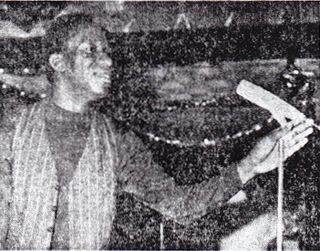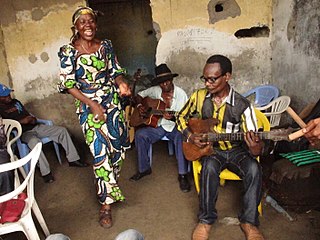Related Research Articles
Simba Wanyika was a Kenyan-based band created in 1971 by Tanzanian brothers Wilson Kinyonga and George Kinyonga, and disbanded in 1994. Simba Wanyika and its two offshoots, Les Wanyika and Super Wanyika Stars, became some of the most popular bands in Kenya. Their guitar-driven sound, inspired by the Soukous guitarist Dr. Nico, combined highly melodic rumba with lyrics sung in Swahili. Simba wa nyika means "Lions of the Savannah" in Swahili.

The music of Kenya is very diverse, with multiple types of folk music based on the variety over 50 regional languages.

Congolese music is one of the most influential music forms of the African continent. Since the 1930s, Congolese musicians have had a huge impact on the African musical scene and elsewhere. Many contemporary genres of music, such as Kenyan Benga and Colombian Champeta, have been heavily influenced by Congolese music. In 2021, Congolese rumba joined other living traditions such as Jamaican reggae music and Cuban rumba on UNESCO's "intangible cultural heritage of humanity" list.

The music of the Cameroon includes diverse traditional and modern musical genres. The best-known contemporary genre is makossa, a popular style that has gained fans across Africa, and its related dance craze bikutsi.

Sierra Leone's music is a mixture of native, French, British, West Indian and Creole musical genres.

Soukous is a genre of dance music originating from the Democratic Republic of the Congo and the Republic of the Congo. It derived from Congolese rumba in the 1960s, with faster dance rhythms and bright, intricate guitar improvisation, and gained popularity in the 1980s in France. Although often used by journalists as a synonym for Congolese rumba, both the music and dance associated with soukous differ from more traditional rumba, especially in its higher tempo, song structures and longer dance sequences.

A rhythm section is a group of musicians within a music ensemble or band that provides the underlying rhythm, harmony and pulse of the accompaniment, providing a rhythmic and harmonic reference and "beat" for the rest of the band. The rhythm section is often contrasted with the roles of other musicians in the band, such as the lead guitarist or lead vocals whose primary job is to carry the melody.

Benga is a genre of Kenyan popular music. It evolved between the late 1940s and late 1960s, in Kenya's capital city of Nairobi. In the 1940s, the African Broadcasting Service in Nairobi aired a steady stream of soukous, South African kwela, Congolese finger-style guitar and various kinds of Cuban dance music that heavily influenced emergence of benga. There were also popular folk songs of Tanzania and Kenya's Luo peoples that formed the base on benga creation.

Pascal-Emmanuel Sinamoyi Tabu, better known as Tabu Ley Rochereau, was a leading African rumba singer-songwriter from the Democratic Republic of the Congo. He was the leader of Orchestre Afrisa International, as well as one of Africa's most influential vocalists and prolific songwriters. Along with guitarist Dr Nico Kasanda, Tabu Ley pioneered soukous and internationalised his music by fusing elements of Congolese folk music with Cuban, Caribbean and Latin American rumba. He has been described as "the Congolese personality who, along with Mobutu, marked Africa's 20th century history." He was dubbed "the African Elvis" by the Los Angeles Times. After the fall of the Mobutu regime, Tabu Ley also pursued a political career. His musical career ran parallel to the other great Congolese rhumba bandleader and rival Franco Luambo Makiadi who ran the band TPOK Jazz throughout the 1960s, 1970s and '80s.

Congolese rumba, also known as African rumba, is a dance music genre originating from the Democratic Republic of the Congo and the Republic of the Congo. With its rhythms, melodies, and lyrics, Congolese rumba has gained global recognition and remains an integral part of African music heritage. In December 2021, it was added to the UNESCO list of intangible cultural heritage.
Muziki wa dansi, or simply dansi, is a Tanzanian music genre, derivative of Congolese soukous and Congolese rumba. It is sometimes called Swahili jazz because most dansi lyrics are in Swahili, and "jazz" is an umbrella term used in Central and Eastern Africa to refer to soukous, highlife, and other dance music and big band genres. Muziki wa dansi can also be referred to as Tanzanian rumba, as "african rumba" is another name for soukous.
Franco and Afro Musica is a twelve piece kwasa kwasa band from Gabane, Botswana.
Jonah Sithole (1952–1997) was a Zimbabwean guitarist, vocalist and composer, known particularly for the mbira-inspired style known as mbira-guitar or chimurenga music.
Mose Se Sengo was a guitarist, composer and band-leader from the Democratic Republic of Congo. He was one of the pioneers of Congolese Soukous.
The Cuban Marimba Band was an influential Tanzanian big band from the city of Morogoro. It was founded in 1948 by Salum Abdullah, who had previously formed the Morogoro Jazz Band. For about twenty years, Cuban Marimba was one of the most popular muziki wa dansi bands in Tanzania.
Morogoro Jazz Band, also known as K.Z. Morogoro Jazz Band, was a seminal muziki wa dansi band from Morogoro, Tanzania. The band originally played live at the clubs and bars of Morogoro and became very popular in the 1960s and 1970s, receiving considerable airplay from Tanzanian radio stations. The leader of the band was guitarist Mbaraka Mwinshehe, who dropped out of school to join the band in 1965. Coincidentally, the band was formed the same year Mwinsheshe was born, in 1944. The original lineup of the band featured Makala Kindamile, Joseph Thomas, Seif Ally, Daudi Ally and Shaabana Mwambe. Salim Abdullah, who would later found Cuban Marimba Band, was also an early member of the band.
Orchestra Maquis Original is a Tanzanian muziki wa dansi band, originally from DR Congo. Founded in 1970 and still in activity, it is one of the most long-lived dansi bands.
Msondo Ngoma is a Tanzanian muziki wa dansi band. Having been established in 1964, it is the oldest active dansi band in Tanzania.
Orchestra Safari Sound (OSS) was a major Tanzanian muziki wa dansi band in the 1970s. Along with Orchestra Maquis Original, OSS contributed to the evolution of dansi, introducing a slower-paced and more melodic style that further differentiated dansi from its ancestor genre, the Congolese soukous. The band was led by Ndala Kasheba, one of the most popular musicians in Tanzanian pop music.
Syran Mbenza is a guitarist, originally from the Democratic Republic of the Congo, who has lived in Paris since about 1981. He has recorded and performed prolifically over five decades, including as a solo artist; as one of the four members of the popular soukous "supergroup" Les Quatre Étoiles; as a founding member of the acoustic, Congolese rumba revival band Kékélé; in other bands; and in support of numerous artists. He has been described as one of the greatest guitar players of Africa.
References
- ↑ Alla scoperta della musica dansi
- ↑ Jeff Finke, The Rough Guide to Tanzania, p. 545
- 1 2 East Africa: Seventies Music is All the Rage Again (African Beats)